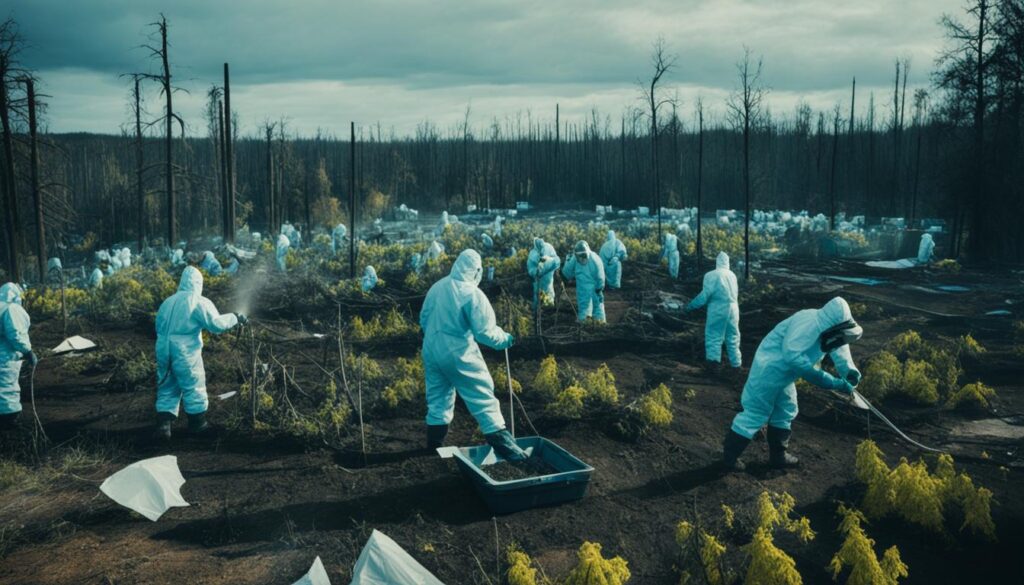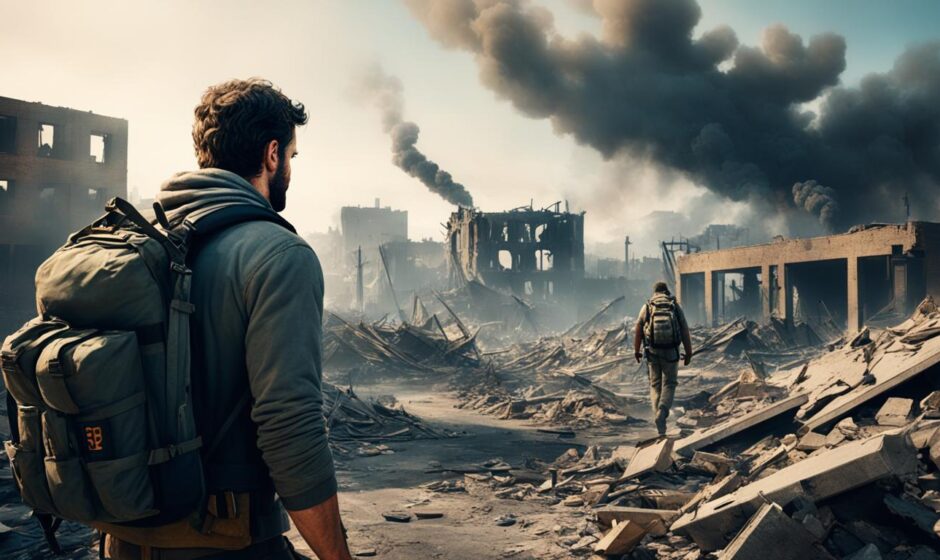World War 3 is unlikely to be a direct kinetic war between the US, Russia, and China. Instead, the conflict will play out on different levels—proxy wars, economic wars, financial wars, cyber wars, biological wars, deniable sabotage, and information wars.
As the world braces for the potential impact of such a conflict, understanding the key battlefields becomes crucial for surviving World War 3 and ensuring global stability.
In this article, we will delve into the 7 key battlefields that will shape the outcome of World War 3. From financial warfare and economic warfare to cyber warfare and information warfare, each domain carries its own significance and impact.
Warfare has evolved, extending beyond conventional military conflicts. Proxy wars fought in distant lands, economic sanctions crippling nations, and cyber attacks paralyzing critical infrastructure are just some of the strategies employed.
Join us as we explore each battlefield, uncovering the strategies and tactics employed by both sides. From the US-led NATO & Friends alliance to the BRICS+ group led by China and Russia, tensions run high, and the potential for conflict looms large.
Surviving World War 3 requires a comprehensive understanding of the multifaceted nature of the conflict. By navigating these key battlefields, we can hope to secure a future of stability and peace.
Domain #1: Financial Warfare
Financial warfare plays a crucial role in the modern battlefield, with economic wars and sanctions becoming powerful weapons for nations seeking to achieve their military and political objectives. In this domain, the use of financial methods to exert pressure and control can have far-reaching consequences.
One of the primary tactics employed in financial warfare is the imposition of sanctions or embargoes. By restricting trade and limiting access to international financial systems, nations can effectively cripple their opponents’ economies. This disruption can severely impact vital sectors such as energy, defense, and technology, rendering them vulnerable to external pressures.
Another significant aspect of financial warfare is freezing assets, which can swiftly cripple the financial capabilities of targeted nations or entities. It involves seizing or blocking access to funds held in banks, making it difficult for the affected party to conduct essential transactions or investments.
“Where weapons and armies can be overt and easily recognized, financial warfare operates in the shadows, exerting its influence covertly.”
The United States has been at the forefront of employing aggressive financial warfare tactics. In the context of World War 3, the US has specifically targeted Russia with a wide array of economic sanctions. These extensive sanctions have led to significant economic challenges for Russia, making it the most sanctioned nation in the world.
| Economic Warfare Tactics | Impact |
|---|---|
| Imposing sanctions | Restricts trade and access to international financial systems |
| Freezing assets | Cripples financial capabilities |
| Restricting trade | Disrupts vital sectors and weakens economic stability |
Financial warfare has become a key tool in modern conflicts, leveraging economic leverage to achieve military or political goals. As World War 3 continues to unfold across various domains, the impact of financial warfare will be a critical factor in determining the outcomes and shaping the geopolitical landscape.
Domain #2: Economic Warfare
Economic warfare is a critical battlefield in World War 3, involving the strategic control of commodities and trade routes. Countries that hold sway over these key resources can exert significant influence over their adversaries. Two major players in the economic warfare domain are Russia and China.
Russia has established dominance in the export of several strategic commodities. It stands as a major supplier of natural gas, lumber, wheat, and palladium. Additionally, Russia is a significant producer of uranium and gold, further enhancing its economic influence.
China, on the other hand, has a firm grip on rare earth elements (REEs) production and processing. REEs are vital for various industries, including technology and defense. With its control over these critical resources, China holds a significant advantage in economic warfare, particularly concerning the US military and consumer market.
Another noteworthy factor in economic warfare is the prominence of BRICS countries – Brazil, Russia, India, China, and South Africa. These nations collectively possess a commanding share in global strategic commodities, further increasing their advantage in this domain.

The Implications of Economic Warfare
Economic warfare can disrupt supply chains, impact economies, and undermine the stability of nations. The control and manipulation of strategic commodities offer powerful leverage to shape global dynamics. By exerting control over these resources, countries can gain economic power, advance their geopolitical goals, and weaken their adversaries.
The interplay of economic warfare, trade restrictions, and resource exploitation reveals the intricate geopolitical strategies employed by nations during World War 3. The battle for control over strategic commodities is just one aspect of the broader conflict, showcasing the multifaceted nature of this global crisis.
Domain #3: Cyber Warfare
Cyber warfare is a critical domain in World War 3, involving digital attacks aimed at disrupting computer systems and infrastructure. The use of cyber attacks in this conflict has targeted various sectors, including government networks, financial systems, and utility services. These attacks have far-reaching implications, as they can paralyze essential services and compromise national security.
Both NATO & Friends and BRICS+ are skilled at cyber warfare, employing sophisticated tactics and techniques to gain the upper hand. However, the nature of cyber warfare allows for anonymity and deniability, making it challenging to determine a decisive advantage for either side. The cyber battlefield is constantly evolving, with new vulnerabilities and attack vectors emerging regularly.
Developing advanced cybersecurity measures and enhancing resilience is crucial in defending against cyber attacks. It requires continuous monitoring, threat intelligence, and robust defense systems to detect and mitigate potential threats. By staying updated on the latest cyber threats and adopting proactive defensive strategies, nations can better safeguard their critical infrastructure and protect their citizens from the devastating consequences of digital attacks.
“Cyber warfare is the new battleground, where nations clash in the virtual realm, with far-reaching consequences.” – Cybersecurity Expert
| NATO & Friends | BRICS+ | |
|---|---|---|
| Strengths | Advanced cybersecurity capabilities | Skilled cyber warfare units |
| Weaknesses | Reliance on interconnected systems | Limited international influence |
| Opportunities | Collaborative intelligence sharing | Exploiting emerging technologies |
| Threats | State-sponsored cyber attacks | Rapidly evolving cyber threats |
Domain #4: Information Warfare
Information warfare plays a crucial role in shaping the narrative and influencing public opinion during times of conflict. It aims to manipulate the information landscape, disrupt communication channels, and spread propaganda to sway the decision-making process. In World War 3, information warfare is a powerful tool used by both sides to gain an upper hand.
One notable player in information warfare is the United States, which holds a significant advantage due to its control over global mainstream media, entertainment industry, and Big Tech platforms. These platforms have become influential sources of information for the general public, making it easier for the US to shape public opinion in its favor.
“The information landscape has become a battleground, where the dissemination of misinformation and propaganda can sway public opinion and influence the course of the war.”
Through various techniques like censorship, amplification of certain narratives, and targeted disinformation campaigns, information warfare can create a distorted perception of reality. This can directly impact how people perceive the actions and intentions of different nations involved in World War 3.
Public opinion holds immense power during times of conflict, shaping political decisions, and influencing the willingness of a nation to engage in warfare or seek peaceful resolutions. Thus, information warfare becomes a critical domain in gaining an advantage over the adversary.
The Power of Propaganda
Propaganda is a key component of information warfare, aiming to manipulate emotions, beliefs, and perceptions. By controlling the narrative, propagandists can sway public sentiment and gain support for their own interests. In World War 3, both sides heavily rely on propaganda to shape public opinion and maintain morale.
| Propaganda Tactics | Example |
|---|---|
| Discrediting the Enemy | Spreading false narratives and rumors about the enemy’s atrocities |
| Eliciting Empathy | Highlighting personal stories of victims to generate sympathy for one’s own cause |
| Creating a Sense of Unity | Portraying the nation as resilient and united against the common enemy |
| Dehumanizing the Enemy | Using derogatory terms and imagery to portray the enemy as subhuman |
Propaganda is a powerful tool that can sway public opinion and justify an agenda. Be it through traditional media outlets, social media platforms, or covert operations, propagandists exploit psychological vulnerabilities to shape public sentiment in their favor.
The Battle for Public Opinion
In World War 3, winning the battle for public opinion becomes as crucial as securing military victories. The control over information channels and the ability to manipulate narratives can significantly impact the perception of the conflict, both domestically and globally.
“Public opinion acts as a force multiplier in modern warfare. The ability to shape and control narratives is a strategic advantage that directly affects the outcome of the conflict.” –
By presenting themselves as the righteous defenders of freedom, democracy, or national sovereignty, nations engaged in World War 3 aim to gain support from their own population, rally allies, and undermine the legitimacy of their adversaries. The ability to gain sympathy and portray one’s cause as just can tip the scales in favor of a nation.
However, with the proliferation of information sources and the rise of alternative media, the effectiveness of information warfare is always challenged. Critical thinking, media literacy, and multi-source verification become essential tools in deciphering the truth amidst the chaos.
With the ever-increasing importance of information warfare in contemporary conflicts, understanding its nuances and recognizing the influence it holds over public opinion becomes crucial in navigating the complex battlefields of World War 3.
Domain #5: Deniable Sabotage
Deniable sabotage plays a significant role in World War 3, as it involves the deliberate obstruction or damage to vital infrastructure without conclusive evidence of the perpetrator. Recent events have highlighted the destructive impact of deniable sabotage on critical systems.
“Deniable sabotage has emerged as a covert weapon, enabling both NATO & Friends and BRICS+ to undermine their adversaries’ infrastructure efficiently.”
– John Fields, former NSA
One notable example of deniable sabotage is the destruction of Russia’s Nord Stream 2 pipeline, which was targeted to disrupt the country’s energy infrastructure. The attack inflicted significant economic and strategic consequences, amplifying tensions between NATO & Friends and BRICS+.
Another instance of deniable sabotage involves the cutting of undersea fiber optic cables, a vital component of global communication networks. These deliberate acts of sabotage aim to disrupt international connectivity and create chaos in information flows.
In the realm of deniable sabotage, both NATO & Friends and BRICS+ have honed their skills, employing strategic attacks to weaken their adversaries’ infrastructure. However, there is no clear decisive advantage for either side in this domain.
Implications of Deniable Sabotage
Deniable sabotage poses significant challenges for national security and global stability. Targeting critical infrastructure such as energy networks, transportation systems, and communication channels can cripple economies and sow chaos.
Moreover, deniable sabotage can escalate tensions between adversaries, fueling retaliatory actions and potentially pushing the conflict closer to conventional warfare.
As the world grapples with the complexities of World War 3, it is crucial to understand the implications of deniable sabotage and develop strategies to mitigate its impact.
Key Takeaways:
| Deniable Sabotage | Implications |
|---|---|
| Intentional obstruction or damage to vital infrastructure | Significant economic and strategic consequences |
| Notable examples: Nord Stream 2 pipeline destruction, cutting of undersea fiber optic cables | Escalation of tensions and potential push towards conventional warfare |
| Both NATO & Friends and BRICS+ possess expertise in deniable sabotage | No clear decisive advantage for either side |
Understanding deniable sabotage and its implications is crucial for navigating the complexities of World War 3 and safeguarding global stability.
Domain #6: Biological Warfare
Biological warfare poses a significant threat in the battlefield of World War 3. It involves the utilization of biological toxins or infectious agents to incapacitate or eliminate targets. These agents can be spread through the air, affecting not only humans but also animals and plants. The devastating consequences of biological warfare can rapidly spread, causing widespread casualties and disrupting social, economic, and political structures.
In the absence of specific details or examples provided in the sources for this domain, it is crucial to acknowledge the potential catastrophic impact of biological warfare in shaping the outcome of World War 3. The use of infectious agents and the deliberate targeting of vulnerable populations can lead to a devastating loss of life and long-term societal consequences. Vigilance, preparedness, and advanced medical capabilities will be crucial in countering the threats posed by biological warfare.
Historical Examples of Biological Warfare
| Event | Description |
|---|---|
| Bubonic Plague as a Biological Weapon | During the Middle Ages, armies used plague-infected corpses as a means to spread the disease among enemy forces, resulting in widespread death and devastation. |
| Japanese Unit 731 | During World War II, the Imperial Japanese Army conducted biological warfare experiments on prisoners, exposing them to deadly diseases, including bubonic plague, anthrax, and cholera. |
| Anthrax Attacks in the United States | In 2001, letters containing anthrax spores were mailed to media organizations and congressional offices, resulting in several deaths and widespread fear across the nation. |
These historical examples serve as stark reminders of the destructive capabilities of biological warfare. As World War 3 looms on the horizon, the need for international cooperation, strict regulations, and effective countermeasures becomes even more critical. It is essential to invest in robust defense systems, intelligence gathering, and international agreements that prohibit and deter the use of biological weapons. Only through concerted efforts can we mitigate the potential devastation caused by biological warfare.

Domain #7: Conventional Warfare
In the realm of military conflict, conventional warfare takes center stage. It encompasses traditional battles fought by forces on the ground, in the air, and at sea. While the detailed notes from our sources do not provide specific examples or details for this domain, conventional warfare remains a critical aspect of any major military engagement.
Conventional war involves the use of conventional weapons, tactics, and strategies. It typically includes large-scale deployments of troops, tanks, artillery, naval vessels, and fighter jets. The goal is to achieve victory through direct force and overwhelming firepower.
Conventional warfare has been a dominant form of military conflict throughout history. It has shaped the outcomes of countless wars and played a significant role in shaping global politics. However, in the context of World War 3, where multiple domains of warfare are at play, the conventional war domain may not be the primary focus of the conflict.
While the conventional war domain may not receive as much attention as other domains, it remains a crucial aspect of any military conflict. It is essential to consider the capabilities and strategies of nations’ armed forces, their technological advancements, and their ability to adapt to evolving battlefields. To fully understand the dynamics of World War 3, we must not overlook the potential impact of conventional warfare.
“In conventional warfare, the clash of armies and the engagement of military forces on the ground, in the air, and at sea play a vital role. While other domains of warfare may dominate the headlines, it is important to remember the power and significance of conventional forces.”
Surviving World War 3: The Key to Stability
As the possibility of World War 3 looms, it becomes crucial to understand the complexity of the conflict and the multiple domains in which it will unfold. Surviving this global catastrophe and achieving stability on a global scale will require a comprehensive approach that navigates the key battlefields involved.
From financial warfare to cyber attacks, biological warfare to deniable sabotage, each domain presents unique challenges and threats. Financial warfare, for instance, involves using economic tactics such as sanctions and embargoes to cripple nations. Meanwhile, cyber warfare focuses on digital attacks that disrupt critical infrastructure.
Information warfare also plays a significant role, with the manipulation of public opinion and the dissemination of propaganda. Additionally, deniable sabotage, biological warfare, and conventional military conflict further contribute to the intricacies of World War 3.
In order to survive this unprecedented global conflict and achieve global stability, it is imperative to develop a deep understanding of these key battlefields. Combining strategic thinking, effective communication, and innovative solutions will be essential to navigate the complexities and mitigate the devastating impacts of World War 3.
